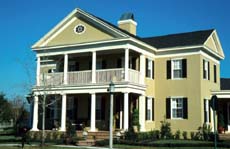index
Houses in Celebration
click on images for full-size:





House at Celebration

House at Celebration

House at Celebration

House at Celebration
Celebration's houses seemed familiar; they were at first glance about what I expected after seeing Kentlands. But on second glance, in Celebration the houses seemed divided into distinct style groups. In fact the architectural code for Celebration is written in terms of permitted styles: "Spanish," "Victorian," and so on. Whereas in most New Urbanist developments the architectural codes do not mention particular styles, but talk about volumes, roof lines, windows, porches, and the like. The effect may be to narrow the palette of styles, but there is still room for unexpectedly creative interpretations of the guidelines. Also, the houses at Celebration are on average bulkier than those at Kentlands or Seaside. Some are quite large, especially in the North Village upper class section. The look of the houses is more varied than in the monotonous subdivisions down the road, but seemed less varied than Seaside or Kentlands, and was certainly less varied than in the older suburbs of my youth. Another distinguishing feature is that Celebration house lots are generally narrower than in than a typical suburb, but the lots are also quite deep, so that houses tend to have long flat sides that contrast somewhat awkwardly with their more decorated fronts. Everything is tasteful, relentless design. There are fewer fences than at Kentlands, and porches seem more prominent. All the houses built so far are within easy walking distance of a park or the lakefront. I had the feeling that allowed set of house styles in Celebration encouraged too many vertical lines for the Florida landscape. Frank Lloyd Wright might protest that on this flat land the houses should be more horizontal. But could you build one of his houses on these narrow lots? Could you imagine his Usonian houses into a New Urbanist development? It would not have been his choice; his Broadacre City was much less dense.